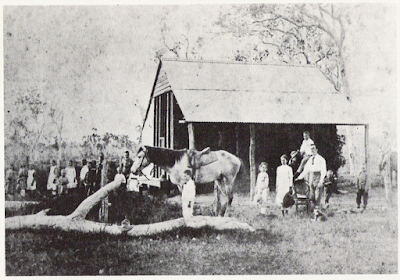In the late
nineteenth century, Australian states took tentative steps towards compulsory
school attendance for children between the ages of six and fourteen years. Queensland’s
Education Act 1875 provided for free,
compulsory, secular education with a basic curriculum that focused on
arithmetic, grammar and reading and writing, along with some physical
activities and lessons in singing, sewing and needlework.
 |
|
The original schoolhouse at the Ross River
Provisional School, sometime between 1889 and 1892. The teacher was Alexander
Duncan.
Photo: courtesy of Lyn Phillips.
|
In 1880, the area
between Aitkenvale and Alice River, and up to what is now the dam, was sparsely
populated by families in rural occupations such as dairying, wood-cutting and
farming.
At this time children
made a significant contribution to the effective functioning of the family unit
by assisting with domestic and general chores such as carting water, collecting
firewood, milking cows, and looking after livestock.
Despite this, the
community at Ross River, as it was known, saw the importance of educating their
children and began agitating for a Provisional School to be established in the
area.
In August, Thomas
Gleeson, Jorgen Rasmussen, William Thorburn and Thomas Lawrence were elected as
members of a Building Committee to establish the Ross River Provisional
School. The number of children in the area of school age was about 30.
The original
schoolhouse opened on 11 April 1881 and although the school initially struggled;
with low enrolments, difficulty retaining teachers due to low pay, and only
basic resources, the school survived to overcome all obstacles that came its
way.
In 1934, wet
season floodwaters threatened the school when the nearby weir wall, which was
nearing completion, was severely damaged. At the height of the flood, a
considerable section of the left bank of the river was washed away and it was
feared that if the erosion continued, the school and its pupils might be in
grave danger.
Thankfully no
further erosion occurred, but the flooding resulted in the school being within
only 18 metres of the riverbank. The following year, in keeping with its
location, the school changed its name to Weir State School.
 |
| Pupils at the Weir State School, 1937. (The School changed its name to Weir in 1935) Photo: Courtesy of Lyn Phillips. |
In April 1942, the
RAAF informed the District Inspector (for schools), Mr E. Walton, that an
additional RAAF squadron was to be stationed near the school, and an aerodrome
would be built close by.
Once the aerodrome
was in use it would have been almost impossible to conduct lessons at the
school because of its proximity to the runway, and as a result, lessons were
moved to the residence of Mrs T. Cooper, who lived about 1.2 km away.
Mrs Cooper was
apparently “only too pleased to allow the school to be conducted in her grounds
and on the verandahs of her house for as long as was required,” and all without
cost to the Department of Public Instruction.
At that time there
were 11 pupils at the Weir State School and most of them lived closer to Mrs
Cooper’s house than they did to the school, so it seemed to be a perfect
solution.
Unfortunately,
when the RAAF vacated the Weir School buildings, they were left in a dreadful
state of disrepair. Among other things, timber from doors, windows, sashes,
verandah floorboards and fence posts had reportedly been removed and used for
fires for cooking by the personnel stationed there.
In April this year (2016), Weir State School will reach a milestone of 135 years since its founding.
With thanks to Lyn Phillips, who provided me with information for this article.
Hi Trisha. Thank you for a very interesting blog. Not sure if you saw it but I sent a text to the editor after reading this story about the Weir School in the paper. My elderly neighbour also told me that the school moved to the Cooper home during WW2. The house is still standing at 502 Ross River Road, Cranbrook. It used to be a dairy farm she told me. Several very old mango tress and a lovely big Leichhardt tree are also still there. The house has been altered over the years but the basic unlined 1880s structure is still inside.
ReplyDeleteHi Jenny, thanks for your comment. I didn't see the text to the editor, but thanks for letting me know. Isn't it marvellous that the house is still there? There must be some stories in that old house, for sure.
DeleteRegards,
Trisha